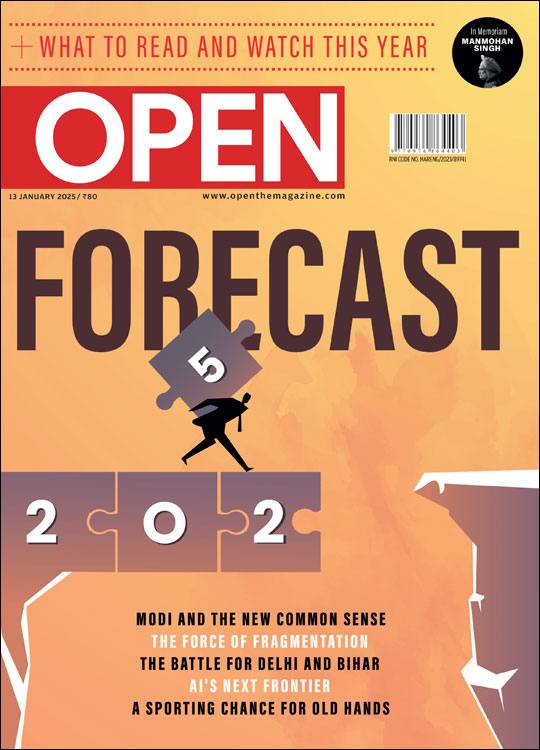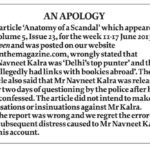I Want a Gun
Women who covet that weapon and other stories of a bold new pursuit
 Avirook Sen
Avirook Sen
 Avirook Sen
|
03 Feb, 2011
Avirook Sen
|
03 Feb, 2011
/wp-content/uploads/2015/11/gun2.jpg)
Women who covet that weapon and other stories of a bold new pursuit
I meet Shreya Nakra Sharma at Ambience mall, just past the toll gate into Haryana, where, above the flats of shrinking mustard fields, you see the rising neon and glass of the future of India—dwarfing and hiding its recent rural past. At the Costa Coffee outlet, we settle down to discuss not the quality of the latte or the ‘popcorn’ chicken next door, but Shreya’s need to own a gun.
She is a confident, articulate member of the middle management of a leading BPO company. She’s been in Delhi for the past eight years; now lives in its suburb Gurgaon; is married to a pilot. And, she says, she has felt less safe.
She wants that weapon. Something convenient—concealed, but ready.
“I grew up in smaller cities. While growing up in colonies that were protected and isolated, this was never an issue. I moved to Delhi in 2003, and I’ve seen the city change even in that span of time—for the worse.”
“There are limited alternatives. You could learn martial arts, but it’s fairly easy for a group of men to overpower you. You could scream for help. But often people won’t come forward… they are so scared. So what choices are you left with if you want to protect yourself?”
“I often work late. My husband is away a lot. I’m all alone at times. And every day, the paper says there’s been a rape somewhere or an assault…”
Among her friends, it’s a discussion that comes up frequently, because the problem is a common one for working urban women in India. On occasion, Shreya’s solution comes up as well.
“My friends’ reaction is usually one of shock. They can’t imagine themselves carrying a gun or pulling one out. In our culture, you don’t expect educated responsible citizens to carry weapons. You expect cops, robbers or ‘macho’ guys who push people around to have them.”
Her friends feel they might be considered outliers should they pack a weapon, that people would categorise them as ‘avoidable’. And then, there is the scary idea that it can kill. “If I don’t carry a gun and I don’t intend to kill anyone, I won’t. But if I have a gun, even if I don’t intend to kill someone, I just might.”
Shreya breaks that, saying, “It takes time to get over these initial fears.” Some of her friends are coming around.
She has shot an air gun. I ask how good she is. “I’m not a crack shot, but I get it right most of the time, and even if I get it wrong, it isn’t by much.”
Looking around the mall, I wonder how many people would expect the diminutive young lady sitting across me to have a handbag whose contents included something that could kill them.
“So if you did have a gun,” I venture to ask her, “when would you use it?”
There was once a situation when she and some others in the family, including her husband, were waiting for the elevator in a mall close to midnight. A bunch of Haryana hoods deliberately stuffed themselves into the same car. “I have my alerts on. I could see these guys didn’t look polished or respectful of women. I would have pulled it out… If every person walking around in this mall had a gun, they would really have to think twice before trying something.”
The consequences that may have followed are academic (though some of the outcomes don’t look very pretty), but I was trying to find Shreya’s threshold for provocation. It worried me a little that lack of “polish” and lack of “respect for women” had a blurry line separating them. I would hear more about it, from other women, reinforcing Shreya’s point of view. But, let’s face it, we make judgments like this in our wonderful, diverse and overcrowded country all the time. (Although when one of the women complained of “smelly” men, suggesting body odour as an indicator of dodgy intentions, I thought it a bit of a stretch.)
Shreya continued. At the root of her frustration is the constrained choice in exercising what in India is a legal right—applying for a gun licence under the Arms Act, 1959. (It replaced a Raj-era law of 1878 that let only Europeans and ‘loyal’ Indians have guns.) According to her, and a small but growing lobby, the Government is making it harder for women like her to own a weapon, effectively taking the choice away by making the process of acquiring a licence painful and prolonged. If your local authority actually wants to grant you one, it could be yours for Rs 100, but now you have to claim that there is an ‘imminent and grave threat’ to your life, and a number of State agencies need to verify your claim. This change in policy came about in March 2009, under Union Home Minister P Chidambaram’s watch.
All the while, argues Shreya, those who want to take advantage of vulnerable, law-abiding citizens go about their business with greater opportunities and fewer hindrances.
We are joined by one of the people who shaped Shreya’s thinking. Her father-in-law, Dr Alok Sharma. He used to be in the Army, now lives in the UAE, but retains his all-India gun licence. Dr Sharma has strong views.
I ask him the Jessica Lal question. Would it have made a difference if she had a weapon? He says that it might have. Or if a responsible person around her had one. “Manu Sharma’s weapon could be shot out of his hand. Or he might have been disabled otherwise.”
But Tamarind Court scenarios are hard to reconstruct, and Dr Sharma shifts the topic to legal gun ownership. “A Manu Sharma will still get a licence. Will still get an all India type of licence. The restrictions are for commoners. Who will deny a licence to a minister’s or bureaucrat’s son?” For the rest of us, he says, the easier way is to break the law: get one off the black market. Estimates vary, but it has been reported that there are about 40 million illegal arms in India, against 5.5 million licenced weapons.
Dr Sharma tells me a story. “When I was in class 9, studying in a village here which is now in Greater Noida, one of my friends was beaten up. He bought a 12 bore country-made pistol for just Rs 200 and five cartridges. He wanted to kill those people who had beaten him up. I’m talking about 40 years back. Things are much worse today.”
“Did he manage to kill them?”
“No. Luck saved those guys. In the dead of night, a group of us went on cycles. We parked the cycles outside the village, and then a stray dog came and took about a 200 gm chunk of flesh off one of the boys. And we ran for our lives!”
“Did you shoot the dog?”
“No. We just ran.”
The Sharma clan seemed to like Ambience mall. Shreya’s husband Rakshit now joined us. He sat next to me at the little table for four. He’s short, solidly built, with a not-too-grand but carefully groomed moustache. He owns several guns, although his father prevented him from buying a Rs 16 lakh Baretta.
I asked him what situation would compel him to use one of his weapons. Turning his chair to face me, he spoke in the kind of tone you’d expect of a calm but alert pilot making a rough weather announcement. “My threshold is when I absolutely know that there is a grave threat to my life. Or my family might be at risk. That is an assessment you have to make. Your willingness to use a gun is about how much you value your life…Sometimes bad decisions can be made in these situations. But then I would rather live… Maybe I’d think this person didn’t deserve to be shot… I’d never do it because of a fender bender, for instance. Let’s say I’m wearing a Timex watch today and I have five thousand bucks in my wallet. Maybe I’ll just give it to them. But what if I’m wearing a Rolex?”
“What if?”
“You know you’ve spent your hard-earned money on it, the watch has probably cost you five lakh, would you just hand it out like that? Because you’re at gunpoint or someone’s holding a knife?”
“You tell me.”
“I wouldn’t.”
Rakshit then begins a little demonstration. Pointing across, to about 10 feet away, he says: “If you were at that distance, then I’d pull out the gun and warn you. But if you were at this distance (as we sat at the cramped table), a slashing weapon has a much better chance of killing me. You can cause me a lot of harm.”
“Unless… unless you’re very quick with your gun.”
“Unless I’m very quick.”
We were kind of done. As I wandered off, I thought about thresholds for responsible gun-owners (that is to say, not drunks with licences at a bar). Shreya’s was a variable based on what her instincts told her. Rakshit’s was similar but perhaps better defined: the possible loss of a Rolex watch would do it.
So what does poor Rabindranath Tagore have to do with all of this?
This is what I found myself asking as I read a very interesting document. It was a script for a 7-8 minute film titled, Guns for Peace. Its proposed opening sequence had a visual of Gurudev writing (perhaps in Santiniketan, the ‘abode of peace’), as the super reads: ‘Where the mind is without fear and the head is held high… into that heaven of freedom, my father, let my country awake.’
There is a curious bit of background to this. A small advertising agency recently went looking for corporate work to Jindal Steel and Power. They were told there was none for the time being. However, if the agency was interested in making Guns for Peace, there was some business there.
Prabhakar Soma, of Doodle Doo Design and Advertising, saw this as an opportunity. He was then briefed about the project by Arun Arora, senior vice-president of corporate communications for Jindal, and Abhijeet Singh, a 39-year-old software professional passionate about guns and the individual’s right to own them.
Abhijeet and I had been talking for a while. He is the cyberface of the National Association of Gun Rights in India (NAGRI). He runs a website called Indiansforguns.com, and is active, along with shooters Rahoul Rai and Jaspal Rana, in trying to ensure the movement is seen in the correct light—that is, as reasonable, responsible and righteous.
Before meeting Abhijeet at the Karni Singh shooting range near Surajkund in mid-January, I had asked him where the group met/practised. He mentioned that it was convenient to do this at Naveen Jindal’s personal range in Noida.
Naveen Jindal’s many qualifications (Congress MP, tricolour activist, steel industry success, polo player) sometimes undermine his passion for shooting. He has represented India on a number of occasions, getting podium places in a long list of international competitions. He attended NAGRI’s inaugural meeting on a foggy January day last year and pledged his personal support.
I didn’t know this meant involving the corp comm department of Jindal Steel and Power. The sense I got was that Jindal would prefer to remain in the background on this one. His office did not respond, through intermediaries or otherwise, to interview requests. His very comprehensive personal website mentions his association with the primarily sporting group, the National Rifle Association of India. But that’s about it: nothing on the individual’s right to own a weapon.
Guns are, after all, a tricky issue: not nearly as much for the liberal media’s derision of a pro-gun position, but for the politics of the Congress party, and his future in it. On issues like banning the medieval practice of same-gotra marriages, Jindal was forced to accept the position of the kangaroo courts that decide the fate of his constituency, Kurukshetra, Haryana. Last year, he sent these khap panchayats a wimpish letter of support, outraging women’s groups and forcing his party to distance itself from him.
Taking a pro-gun position and advocating it with any volume would put him in direct opposition to one of the Congress’ current favourites: P Chidambaram, whose ministry NAGRI attacks for discrimination and hypocrisy. (Why does he roam around with armed guards? ‘How can the ministry take the view that ordinary citizens do not have the same right to protect themselves as VIPs do?’ asks a NAGRI handout.)
Within the pale of Congress politics, Jindal has insured himself from damage to an extent. NAGRI’s patron-in-chief happens to be Digvijaya Singh, the powerful general secretary of the Congress whose default reaction to anything Chidambaram does seems to be to oppose it. Digvijaya is a veteran north Indian politician with mainly north Indian concerns. Gun licences, especially in the region of Madhya Pradesh he comes from, are prized almost as much as their moustaches. It has even been reported that vasectomy drives have been conducted in the state with the carrot of a gun licence for those who sign up.
In August last year, Digvijaya led a group of MPs opposing Chidambaram’s policy changes and met the Prime Minister. Manmohan Singh said little, but would surely have marvelled at the diversity of the group. Politicians from all parties seemed to be there. Including a few interesting ones: Brij Bushan Sharan Singh, the now Samajwadi Party man whose name pops up every time newspapers do a story on crime and politics, was protesting indignantly about how responsible firearms owners were being equated with common criminals. (‘Common’ isn’t a word anyone likes.)
Naveen Jindal was there too, doing the same thing. The young MP’s conservative contradictions were partly shaped by his years studying in Dallas, Texas, in the early 90s. He saw students proudly display the American flag, and was inspired to fight for the same right when he returned to India. He would have also tasted life in one of the most firearm-friendly states in the US. Texas’ association with the Wild West, where honour and property had just one friend, the gun, is a Hollywood cliché. But this isn’t as far removed from reality as one might think.
After the recent shooting in Tuscon, Arizona, where several people were killed and a US Congresswoman, now making a painful recovery, was shot by a reportedly deranged individual, Texas was actually moving to relax gun laws further—and cut spending on mental health programmes.
But how do you get from Texas to Tagore? The NAGRI filmmakers want to get there simply by positive association for their cause. This is the insidious bit: it casts the poet as angel patron, when, in fact, his views on guns were, at the very least, philosophically opposed. This is from a speech in Tokyo: “In a little flower there is a living power hidden in beauty, more potent than a Maxim gun.”
The ‘heaven of freedom’ that Tagore was talking about is very different from the one to which Naveen Jindal, Brij Bhushan Sharan Singh, or indeed the Shreya Sharmas of our troubled cities wish to transport themselves with their pieces, in peace.
Alas, we’re not close to either heaven, laments Guns for Peace, echoing things you hear from pro-gun lobbyists everywhere between Tuscon and Tamarind Court. As dramatic footage of a girl being pursued in a dark alley plays out, the voiceover says: “All of us are at risk… our sisters, our mothers, our daughters… stepping out of home, they are at risk… even at home they are at risk.”
As shadows of dagger-wielding men terrorise the viewer, and newspaper clips reinforce a daily blur of violence, the voice says: “The enemy is lurking in every corner, every street, every turning.”
All my chats with the pro-gun lobby seemed to be condensed into the film script, bar one thing: Gandhi.
On the web, and in conversations, they are fond of quoting Gandhi (misleadingly, in the case of Gandhi, but to be fair, they also quote Hitler) from My Experiments with Truth: ‘Among the many misdeeds of British rule in India, history will look upon the Act depriving a whole nation of arms, as the blackest.’
Tagore is one thing, but using images of Gandhi in a film supporting deadly weapons (however responsibly used) is, I believe, a risk that corporate communications at Jindal Steel and Power is unlikely to take. It is a little too daft.
No matter how many late great men are drafted, NAGRI must find a walking, talking icon. Its first meeting tasked some members to do this job.
In 1998, the National Rifle Association (NRA) in the US found their prophet in Charlton Heston. The American public, even those opposed to guns, couldn’t separate him from the heroic Ben Hur, or the wise miracle man Moses they had seen in theatres. The NRA seduced its audience by appearing fearless and free. Lobbying became much easier, its profile rose.
NAGRI, which models itself on the NRA, hasn’t found anyone yet, but reports that Amitabh Bachchan slept well for the first time after the 26/11 attacks only once he had a loaded revolver under his pillow, seem to have encouraged them enough to spread the word that the invincible Mr B shares their concerns. That he promotes everything from hair oil to insurance policies for a price makes the job of finding the Indian Heston that much easier.
Till that prophet-sheriff of India comes along, the pro-gun lobby is using the resources available to hit its target audience. Social media appears to be the weapon of choice. NAGRI has opened membership online and is up to 1,000, including 56 women, about half of them from north India; Indiansforguns.com has over 5,000 users, spread, if a little unevenly, across the country.
The talk on the forums is mainly about one thing: how do I get me a weapon licence. The short answer is: ‘It’s possible, but tough.’
Stories shared on the forum include how you need to prove you are not a poacher if you want a licence in Chandigarh. How the cops in Kolkata won’t register an FIR over a violent property dispute that could make the case for the granting of a licence. How a gentleman transferred to a city different from the one on his licence is struggling to get it extended (licences are typically for one state, VIPs being exceptions to the rule, as with everything else).
And then there is this case of a licence that was held up in Allahabad: ‘Though i have submitted the proof of my residency through a certificate from Tehsildar, Station In-charge is now asking for a certificate from the local councilor stating the same. Now my area councillor is cooling his heels in Jail on a murder charge and is not expected to be out for a long time now. What should i do now?’
Life as a law-abiding citizen who wants to own a gun doesn’t look that great. So calls to action come from recommended reads on the correlation between guns and crime.
I went through one somewhat naïve essay by a chap called Vikram with interest. The National Crime Records Bureau statistics interpreted by the author don’t take into account population growth when talking about the 229 per cent increase in murders from 1953 to 2007 (India had 300 per cent more people by then). The numbers of rapes, robberies and so on are treated equally carelessly.
To this façade of research is applied the gloss of the ‘foreign study’. The favourite, for both the NRA in the US and NAGRI in India, is the work of a University of Maryland professor called John Lott. In the late 1990s, wading manfully through a tsunami of data, Lott and his colleague John Mustard had argued that carrying concealed weapons had reduced crime rates in the US significantly. This theory, once widely publicised, has since been roundly discredited. One review found that the same data could be mined to produce unlikely gems: if you reduced the number of older Black women in America, you would reduce crime at an even faster rate.
Steve Levitt, the maverick economist, once wrote a paper saying gun control, or the lack of it, actually made very little difference to crime rates, and this is something that the Home Ministry, which has conducted no studies of its own, might want to consult.
But our essayist then falls back on the emotive story of the lurking rapist, or the burglar at the senior citizen’s home. Doesn’t the victim stand a better chance with a weapon? The answer, according to Nobel laureate Thomas Schelling, is ‘no’.
Schelling, who laid the foundations of modern game theory, used the identical example—a burglar in the basement—a long time ago. The gun-owning master of the house confronts the armed burglar. Steve Pinker, the Harvard experimental psychologist, explained Schelling’s argument beautifully in a lecture: “Each of them is thinking, ‘I don’t really want to kill that guy, but he’s about to kill me. Maybe I had better shoot him before he shoots me, especially since, even if he doesn’t want to kill me, he’s probably worrying right now that I might kill him before he kills me.’ And so on…”
This ‘guessing and choosing’ game goes on, my friend Parikshit Ghosh, who teaches at Delhi University, tells me. But in reality, the process does not last too long. Both sides understand that the argument needs to collapse on a trigger fairly quickly, or you’re dead. In the end, in an environment of escalating suspicion, it is ‘rational’ to shoot first.
Of all the arguments made by the pro-gun lobby, the logic of freedom of choice is the most compelling.
In Hauz Khas, Shreya Sharma, a designer who often works late, and has plenty of stories to tell about being chased around by louts in Scorpios, says, “If I want a licence, I should be able to get one.” If anything, the process should be made easier for women, she argues.
Amit Gupta, who works in Nehru Place and has interests in real estate in the NCR region and Punjab, carries a weapon at almost all times. He walks through the detectors at the entrance to his office every day, the gun in his laptop bag. When it beeps, he fishes out the decoy—his mobile phone—and blames it for the noise. He carries his gun because he doesn’t want his employees to take him for granted, “say, on payday in Punjab, when I’m carrying a lot of cash.” But his weapon is “heavily concealed”.
Gupta is working on his wife, trying to convince her that the idea of getting a gun is a good one. She is unsure whether she can handle the responsibility of a gun. Unsure whether she can fire it at all if an attacker decides to pay her a visit while her husband is away. Unsure whether she wants to exercise her choice.
Which brings me back to the ‘guessing and choosing’. I need to clarify that Pinker’s arguments were meant as illustrations for larger conflicts: wars of nations, cultures and worlds. All of them, however, can be reduced to one-on-one confrontations between human beings. Here, according to Pinker, is what happens when everybody chooses to own guns purely for their own protection: “You don’t strike first, but you have a publicly announced policy that you will retaliate savagely if you are invaded. The only thing is that this policy is liable to having its bluff called, and therefore can only work if it’s credible. To make it credible, you must avenge all insults and settle all scores, which leads to cycles of bloody vendetta. Life becomes an episode of The Sopranos.”

/wp-content/uploads/2025/01/Cover-Forecast2025.jpg)











More Columns
Union Cabinet and PMO Reshuffle on Cards Short Post
A Politicised Fast Siddharth Singh
An end is a beginning Aditya Iyer